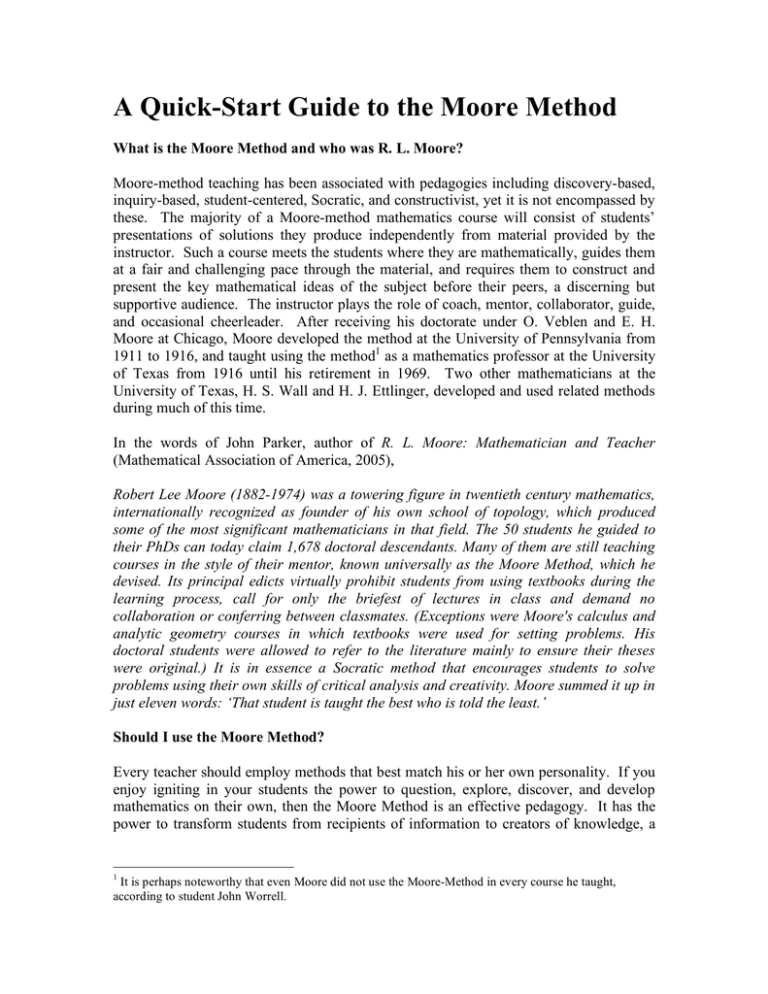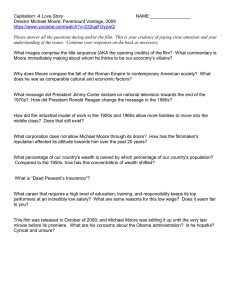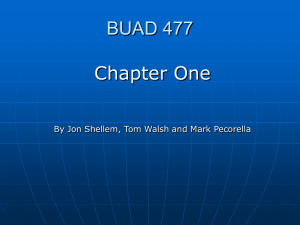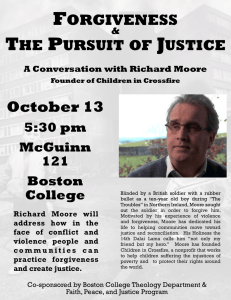A Quick-Start Guide to the Moore Method
advertisement

A Quick-Start Guide to the Moore Method What is the Moore Method and who was R. L. Moore? Moore-method teaching has been associated with pedagogies including discovery-based, inquiry-based, student-centered, Socratic, and constructivist, yet it is not encompassed by these. The majority of a Moore-method mathematics course will consist of students’ presentations of solutions they produce independently from material provided by the instructor. Such a course meets the students where they are mathematically, guides them at a fair and challenging pace through the material, and requires them to construct and present the key mathematical ideas of the subject before their peers, a discerning but supportive audience. The instructor plays the role of coach, mentor, collaborator, guide, and occasional cheerleader. After receiving his doctorate under O. Veblen and E. H. Moore at Chicago, Moore developed the method at the University of Pennsylvania from 1911 to 1916, and taught using the method1 as a mathematics professor at the University of Texas from 1916 until his retirement in 1969. Two other mathematicians at the University of Texas, H. S. Wall and H. J. Ettlinger, developed and used related methods during much of this time. In the words of John Parker, author of R. L. Moore: Mathematician and Teacher (Mathematical Association of America, 2005), Robert Lee Moore (1882-1974) was a towering figure in twentieth century mathematics, internationally recognized as founder of his own school of topology, which produced some of the most significant mathematicians in that field. The 50 students he guided to their PhDs can today claim 1,678 doctoral descendants. Many of them are still teaching courses in the style of their mentor, known universally as the Moore Method, which he devised. Its principal edicts virtually prohibit students from using textbooks during the learning process, call for only the briefest of lectures in class and demand no collaboration or conferring between classmates. (Exceptions were Moore's calculus and analytic geometry courses in which textbooks were used for setting problems. His doctoral students were allowed to refer to the literature mainly to ensure their theses were original.) It is in essence a Socratic method that encourages students to solve problems using their own skills of critical analysis and creativity. Moore summed it up in just eleven words: ‘That student is taught the best who is told the least.’ Should I use the Moore Method? Every teacher should employ methods that best match his or her own personality. If you enjoy igniting in your students the power to question, explore, discover, and develop mathematics on their own, then the Moore Method is an effective pedagogy. It has the power to transform students from recipients of information to creators of knowledge, a 1 It is perhaps noteworthy that even Moore did not use the Moore-Method in every course he taught, according to student John Worrell. valuable and fundamental transformation that transcends the subject of mathematics and benefits students of all disciplines. I want to try the Moore Method. How do I start? A good way to start is by attending a workshop. See if one is available through the Workshop Contact listed below. If not, secure a willing mentor through the Mentoring Contact listed below. Numerous successful mentoring relationships in recent years have been conducted by phone, email, or campus visitation. Considerable literature is available on the method (see Recommended Reading and Web-based Resources). A “how-to manual,” The Moore Method: A Pathway to Student-Centered Learning, by Charles A. Coppin, W. Ted Mahavier, E. Lee May, and G. Edgar Parker is currently being written with drafts available. This brief introduction was written by a subset of the authors of that book, which addresses all the questions in this guide from all four authors’ perspectives. How do I develop or select materials? Secure a set of materials already developed (see Web-based Resources and Contacts), write your own, or use a book. Modifying another’s notes to your needs or writing the first week’s worth of notes and then creating problems dynamically to stay a week or so ahead of the class is practical and assures problems are at the right level. If a mentor in the area you wish to teach has notes, then this is a superb start. Even from a distance, a mentor can help you assess progress in your course while providing insight into the notes and the reasoning behind the content development. Such an introductory experience will give good guidance for preparing your own notes for the next course you teach. Ultimately, once a teacher has some experience creating notes, he or she often uses an outline of notes, but creates problems dynamically as driven by student needs. A very important issue in developing one’s own notes is write the first problems at a level that assures immediate success that will be developed and built on as the course progresses. Each of the following can be obtained through one of the web-based resources listed below: Advanced Calculus, Algebraic Topology, Analysis, Analytic Functions, Calculus, Cohomology, Differential Equations, Differential Geometry, Foundations, Geometry, Graph Theory, Jordan Curves, Linear Algebra, Matrices, Number Theory, Orthogonal Groups, Real Analysis, Spaces of Functions, Statistics, Trigonometry, Vectors, and Voting Theory. What are the student goals for a Moore-Method course? Goals for the course should address both the informational goals (see previous section on developing materials) and student development goals. Consider the following studentcentered goals as a starting point for setting your own goals for students. Goal 1: To independently develop a solution and supporting argument. Hard work and investigation of the topic are the pre-requisites for developing this skill. Goal 2: To communicate that solution via a supporting argument. Having spent the necessary time to solve a problem, the student must present both in written form and orally to the class his or her argument. Goal 3: To defend that argument. During this process, either the presentation is adequate to convince peers of the validity of the solution or the student must defend (or modify) his or her solution. Perhaps the position is indefensible, in which case the student returns to Goal 1 and repeats the cycle. How do I gain the support of my department chair and colleagues? There is inherent risk in stepping outside the box with respect to teaching. Perhaps no one has addressed this risk more succinctly than G. Edgar Parker who wrote, …should you choose to use Moore-method, there are some built-in complications. One of the beautiful things about the method is that when students succeed, they have no one to credit but themselves because they are clearly the ones who have done the work. The flip-side of this is that when students do not succeed, they will blame you because you have not taught them the way they expected to be taught. If one is to choose to put oneself in the position of deferring all credit and being the focus of all blame, such a person had darn well better have the strength of his or her conviction that there is a bigger payoff for the student when using non-traditional pedagogy. After twenty-five plus years of teaching in the cauldron, I remain convinced. Hence, securing support from your administration is prudent. The Educational Advancement Foundation has supported this pedagogy by providing financial support for release time to assure that instructors implementing the method have adequate time to apply the method, by supporting the mentoring program, by supporting materials development, and by supporting workshops on the method. A letter of support or potential funding from the Foundation can convince your department chair that you are striving to better your own teaching, your department’s graduates, and your students’ education through a proven method. What will I do in the classroom each day? Your role will be to facilitate and encourage the classroom discussion, to clarify points or questions raised by students during student presentations (not answer, clarify for the class to answer), and to create an environment in which you are superfluous. You should not be the center of attention and should not say more words, on average, than other members of the class. Exceptions might be when you are tying together results successfully solved by a number of students or elaborating on an argument to give an advanced perspective. The class should be able to conduct itself fully in your absence after only a few weeks. The first day of class is important, as it sets the tone and suggests a standard for the semester. One way to begin is to posit for discussion some elementary questions, at least one of which a student can successfully solve. The moment students indicate a potential solution, encourage them to write it on the board. If they resist, gently nudge them. If they still resist, ask someone to serve as secretary. Get someone to the board early in the period. Even if the proposed solution is incorrect, it should lead (with your coaching) to a whole-class discussion in a relaxed setting before grading or policies are discussed. Once the tone of relaxed presentations is established, send them home with a few problems varying in difficulty. Some problems should assure continued success at the board during the next meeting. Others should assure that brighter or better-prepared students are challenged. Prior to dismissal, make clear that your expectation for the next class meeting is that solutions to one or more of the posed problems be presented by students. In the best possible case, one problem sent home will be named after the student who raised it in class. On a typical day, arrive early, making clear that the class is important to you. Ask for questions and encourage mathematical discussion before class officially starts. Pose a question to get discussion started if it does not occur naturally. Be careful not to allow such discussions to infringe on possible presentations. For instance, an answer to a question might be, “Does someone have problem 23? This solution might help you to answer your question.” Be flexible. If a discussion is on-going, then sit, listen, and support, but don’t dominate. Once class starts, query the students for solutions and watch as they proceed to deliver the solutions to the problems before the class, which should serve as a critical, yet supportive jury to the arguments presented. At times, such as when a question has been posed of a student at the board, there may be long, almost painful, periods of silence while the student formulates an answer. Trust in the students and they will deliver. Stay after class to answer questions until the students have departed. How do I grade a Moore-Method course? Consider using a system that assigns percentages of credit for each of written work, presentation work, and examinations, which may be in-class or take-home. Allow written work to be resubmitted to improve grades and emphasize refinement of arguments. Consider allowing students to choose their own percentages for each portion of their grade. Dividing the weights equally among the three is effective, perhaps adjusting the percentages for classes depending on the maturity of the students. Reserve the right to add weight to one portion of a student’s work at the end of the semester if it benefits the student. Whatever grading system you decide on, it should encourage “learning” over “earning.” The system should reward students for attempting to produce original arguments and for defending (or attempting to defend) these arguments. In essence, it should train a research philosophy in the student that discovering a truth, validating that truth, and presenting that truth will result in a good grade. How do I assess my Moore-Method courses? The mathematics educator and mathematician with the most experience in assessing Moore-Method courses is Jennifer Christian-Smith (see Contacts below). Techniques for assessment used by practitioners include requiring students to keep diaries or journals of their experiences during the course, administering attitudinal surveys about the course, administering pre- and post examinations to determine problem solving ability, saving examples of student work to demonstrate individual student improvement as the semester progresses, and discussing students’ achievements in subsequent classes with the colleagues who “inherit” these students. Web-based Resources • • • • The Legacy of R. L. Moore Website has significant reading materials on-line and lists of other available materials. www.discovery.utexas.edu/rlm The MathNerds Texan Section has the largest collection of free Moore-Method course materials available on the web. www.mathnerds.com/mathnerds/texan The Educational Advancement Foundation accepts proposals for projects promoting the method. http://www.educationaladvancementfoundation.org The Archives of American Mathematics Center for American History at the University of Texas houses the R. L. Moore Archives. This large resource of materials is a good place to dive deeply into R. L. Moore’s life and mathematics or to donate any materials associated with Moore and his descendants. http://www.cah.utexas.edu/collectioncomponents/math.html Recommended Reading History: • • • Traylor, R., Creative Teaching: The Heritage of R. L. Moore, University of Houston Press, 1972. Available on-line at the Legacy site listed above, this will not prepare one to teach a Moore-style course, but it does give a brief and interesting history of the man. Parker, J., R. L. Moore, Mathematician & Teacher, MAA, 2005. Approximately 300 pages about the man and his students, it is not intended to prepare one to teach a Moore-style course, but gives important insight into man and method. Devlin, K., The greatest math teacher, Devlin’s Angle, MAA On-line, June 1999, http://www.maa.org/devlin/devlin_6_99.html. The briefest possible introduction to the man, his accomplishments, his students and his style. Method: • • • • Coppin; Mahavier, W.T.; May; Parker; The Moore Method: A Pathway to Student-Centered Learning, in preparation, drafts available. Intended as a complete “how-to” manual for the method including philosophy and mechanics. Ormes, N., A beginner’s guide to the Moore Method, 1999 (available through EAF on CD) Not a “how-to” guide, rather the reflections of a first-time practitioner. Mahavier, W.S., What is the Moore Method?, Primus, (9)1999, 339-254 (available on-line at the Legacy site). Parker, G.E. Getting More from Moore, Primus, vol. 2 (September 1992): 235246. (available on-line at Legacy site). • Renz, P., The Moore Method: What Discovery Learning Is and How It Works. FOCUS: Newsletter of the Mathematical Association of America (1999) August/September, (available on-line at Legacy site). Moore’s Mathematics and Impact: • • • • Fitzpatrick, B., Some aspects of the work and influence of R.L. Moore, Handbook of the History of General Topology, Kluwer Academic (1)1997 41-61. (available through EAF on CD). Wilder, R.L., The mathematical work of R.L. Moore: its background, nature, and influence, Arch. History Exact Sci. 26 (1982): 73-97. Zitarelli, D., Towering figures in American mathematics, American Mathematical Monthly 108(2001): 606-635 (available through EAF on CD). Zitarelli, D., The Origin and Early Impact of the Moore Method, American Mathematical Monthly 111(2004): 465-486. Contacts Assessment – Jennifer Christian-Smith, jenn.smith@mail.utexas.edu Educational Advancement Foundation, nflores@edu-adv-foundation.org Materials – W. Ted Mahavier, wtm@mathnerds.com Mentoring – Bob Eslinger, eslinger@hendrix.edu Workshops – Stan Yoshinobu, syoshinobu@csudh.edu The Mission of the Educational Advancement Foundation The Educational Advancement Foundation is a 501(c)(3) philanthropic organization that supports (1) the development and implementation of inquiry-based learning at all educational levels in the United States, particularly in the fields of mathematics and science, and (2) the preservation and dissemination of the inquiry-based learning methodology of Dr. R. L. Moore (1882-1974). The Trustees are guided by the principle that The Educational Advancement Foundation should serve as a stimulus for action, providing seed funding for projects with the potential to have a significant impact on Inquiry-Based Learning in the United States. The National Science Foundation regards Inquiry-Based Learning as America's best hope for increasing the mathematical and scientific skills of its populace and is committed to furthering Inquiry-Based Learning at every educational level. The Educational Advancement Foundation agrees with this assessment and is dedicated to assisting in the achievement of that objective. Authorship This document was co-authored by W. Ted Mahavier, E. Lee May, and G. Edgar Parker with input from Robert Eslinger. 7 July 2006



